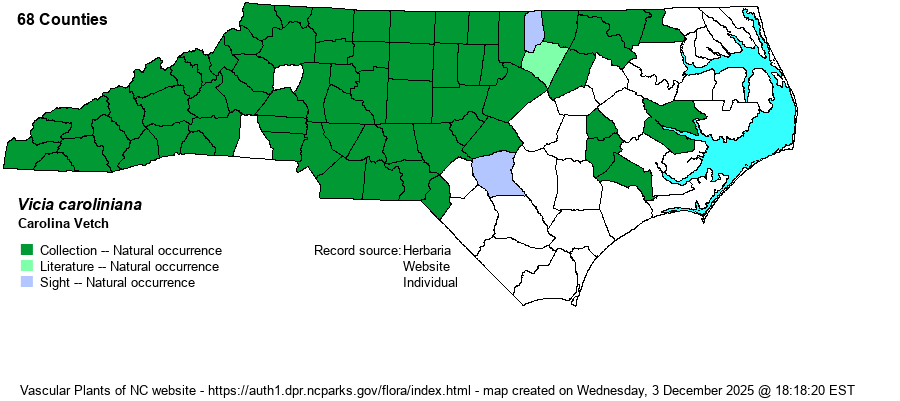| Author | Walter | |
| Distribution | Throughout the mountains and Piedmont; sparingly present over the northern half of the Coastal Plain. Ranges south only to Jones and Cumberland counties in that last province.
This is a widespread Eastern species, ranging from NY and WI south to northern FL and central TX. | |
| Abundance | Common throughout the mountains; frequent to common in the Piedmont (where slightly less numerous than in the mountains); uncommon in the northern parts of the Coastal Plain, except probably absent near the coast. | |
| Habitat | This species, the only native vetch in NC, occurs in dry to mesic, partly shaded places. It is most often seen along woodland borders and roadbanks, but it also is found in openings in upland forests. It does not normally grow in sandy or overly dry soil. | |
| Phenology | Blooms from April to May, sparingly to June; fruits from May to July. | |
| Identification | This is a quite slender, leaning to somewhat erect herb, growing to about 2 feet tall or long. It usually is unbranched and has scattered leaves along the stem, and each leaf is about 3 inches long, with 5-9 pairs of narrow leaflets, and a tendril at the end of each leaf. These leaflets are only about 3/4-inch long. The whole effect is a quite slender and "wispy" plant. Thankfully, the plant has scattered, long racemes of soft pink to whitish flowers, each raceme about 4 inches long, and composed of 20 or more narrow flowers about 1/2-inch long. The flowers sometimes makes the plant look a bit top-heavy, or at least are so prominent that the leaves are almost invisible at a distance. No other native plant looks like Carolina Vetch, and the numerous non-native species tend to have flowers that are purple to blue, yellow, cream, or some other color besides light pink. Also, these grow in fields, meadows, and other places in full sun. This species can be difficult to target for finding, but driving back roads through upland woods, such as along U.S. Forest Service roads in the mountains and Piedmont, can often produce these plants growing on roadbanks. | |
| Taxonomic Comments | None
| |
| Other Common Name(s) | Pale Vetch, Wood Vetch, Carolina Wood-vetch | |
| State Rank | S5 | |
| Global Rank | G5 | |
| State Status | | |
| US Status | | |
| USACE-agcp | FACU link |
| USACE-emp | FACU link |

